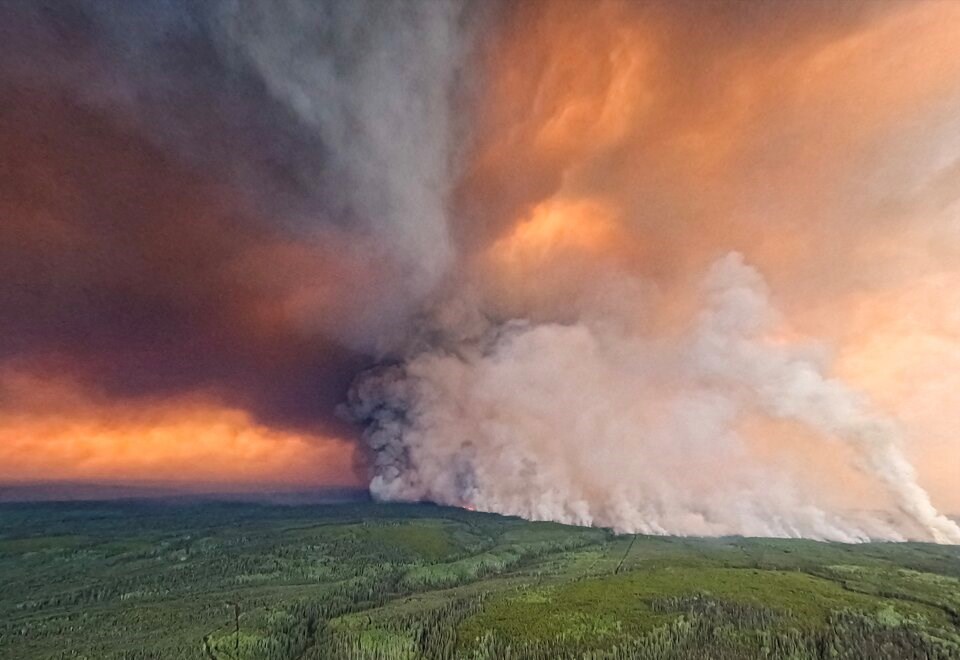sa国际传媒’s 2023 wildfire season breached an all-time record Monday after raging fires torched more than 75,000 square kilometres of land, an area the size of Panama.
By one count, the country reached its historic wildfire season over the weekend — satellite hotspot data showed the country blew passed the previous record, set in 1989, sometime between Saturday and Sunday. The , however, reported sa国际传媒 broke its Monday afternoon.
“We’re in a new territory for fire in a modern record,” said Mike Flannigan, a professor at Thompson Rivers University in Kamloops researching fire weather and climate change.
No matter the timing, one thing was for certain, the record has come incredibly early. The core of sa国际传媒's wildfire season doesn’t usually pick up until the last week of June, and above-average summer temperatures could set the conditions to boost the record even further.
So far, Quebec has seen the most land burned of any province or territory. Alberta, Saskatchewan, sa国际传媒, the Northwest Territories and Nova Scotia have also been hit especially hard. But that could soon change as Environment sa国际传媒 expects hotter-than-normal weather to dominate much of sa国际传媒 over the summer.
“That’s a recipe for fire,” said Flannigan.
The normal peak wildfire season varies across sa国际传媒. Historically, half the land burned in Alberta every year is set ablaze in May.
“Most jurisdictions have passed their prime,” said Flannigan. “With the exception of British Columbia.”
Climate change priming forests to burn
Since the 1970s, the average annual area burned in sa国际传媒 has roughly doubled. And while this year Quebec has faced immense wildfires, Flannigan says the long-term trend is clearest in sa国际传媒
The amount of land burned in British Columbia this year has already placed 2023 among the top three wildfire seasons on record — the other three largest seasons (2017, 2018 and 2021) all came within the last five years.
This year’s Donnie Creek wildfire, which is still growing, is the largest in the province’s recorded history, and has now burned an area twice that of Metro Vancouver.
Experts say it’s part of a trend of bigger, hotter fires burning more often. Part of that is a legacy of fuel left over in Canadian forests after decades of logging. But Flannigan says research is pointing to human-caused climate change playing a bigger role.
The three ingredients of fire
The universal recipe for wildfire requires three ingredients: fuel to burn, a spark to ignite the blaze, and the dry, hot and windy fire weather that lets an inferno spread.
Forest fuels are becoming increasingly available. The rise in global average temperatures is magnified between two to four times higher in sa国际传媒. Those hotter atmospheric conditions act like a kiln, sucking moisture out of the needles, leaves and dead wood of a forest and priming the fuel to ignite into high-intensity fires, says Flannigan.
Every year in sa国际传媒, . The other half are ignited by , but lead to more than 80 per cent of the area burned across the country every year.
The incidents of human-triggered wildfires appears to be going down. Lightning strikes, however, are on the rise.
That’s because human-caused climate change is heating air near the Earth's surface more rapidly than the middle and upper atmosphere. When the hot surface air rises, it creates unstable conditions perfect for thunderstorm formation. The more thunderstorms, the more lightning. One recent study found the in northern boreal forests could more than double by the end of the century.
On Monday, the effects of that trend were on display when the BC Wildfire Service confirmed the province's northeast region was struck with as many as over the weekend.
A hot summer ahead?
sa国际传媒’s record-breaking season this year came after a powerful spring heat wave spread across Western sa国际传媒. Climatologists with Environment sa国际传媒 have already reviewed preliminary data that indicates the event was likely shaped by human-caused climate change.
David Campbell, head of sa国际传媒's River Forecast Centre, warned last week that the hot spring weather combined with low rates of precipitation to melt much of the province's snowpack. The result, he said, is that sa国际传媒's rivers could face not expected for another 30-plus years.
“The fact that we’re trending at historic low in so many rivers right now, we’re headed to a potential worst-case scenario,” he told Glacier Media last week.
Environment sa国际传媒's summer seasonal forecast, meanwhile, calls for across most of the country.
“I’m fairly confident July's gonna be above-normal temperatures for much of sa国际传媒,” said Flannigan.
“It kind of loads the deck for fire.”
With files from the Canadian Press


